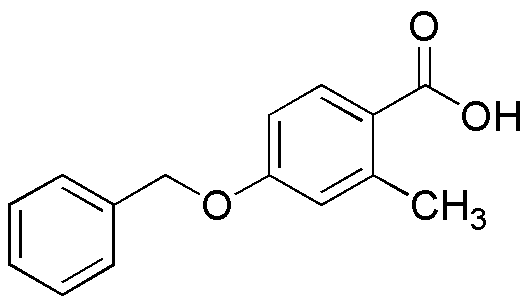4-Benzyloxy-2-methylbenzoic acid is widely utilized in research focused on:
- Pharmaceutical Development: This compound serves as an intermediate in the synthesis of various pharmaceutical agents, particularly those targeting anti-inflammatory and analgesic properties.
- Polymer Chemistry: It is used in the formulation of specialty polymers, enhancing their thermal stability and mechanical properties, which is crucial in industries like automotive and electronics.
- Organic Synthesis: As a versatile building block, it plays a significant role in organic synthesis, allowing chemists to create complex molecules efficiently.
- Research in Material Science: The compound is explored for its potential in developing advanced materials, including coatings and adhesives, that require specific chemical resistance and durability.
- Analytical Chemistry: It is employed as a reference standard in various analytical techniques, aiding in the accurate quantification of similar compounds in complex mixtures.
General Information
Properties
Safety and Regulations
Applications
4-Benzyloxy-2-methylbenzoic acid is widely utilized in research focused on:
- Pharmaceutical Development: This compound serves as an intermediate in the synthesis of various pharmaceutical agents, particularly those targeting anti-inflammatory and analgesic properties.
- Polymer Chemistry: It is used in the formulation of specialty polymers, enhancing their thermal stability and mechanical properties, which is crucial in industries like automotive and electronics.
- Organic Synthesis: As a versatile building block, it plays a significant role in organic synthesis, allowing chemists to create complex molecules efficiently.
- Research in Material Science: The compound is explored for its potential in developing advanced materials, including coatings and adhesives, that require specific chemical resistance and durability.
- Analytical Chemistry: It is employed as a reference standard in various analytical techniques, aiding in the accurate quantification of similar compounds in complex mixtures.
Documents
Safety Data Sheets (SDS)
The SDS provides comprehensive safety information on handling, storage, and disposal of the product.
Product Specification (PS)
The PS provides a comprehensive breakdown of the product’s properties, including chemical composition, physical state, purity, and storage requirements. It also details acceptable quality ranges and the product's intended applications.
Certificates of Analysis (COA)
Search for Certificates of Analysis (COA) by entering the products Lot Number. Lot and Batch Numbers can be found on a product’s label following the words ‘Lot’ or ‘Batch’.
*Catalog Number
*Lot Number
Certificates Of Origin (COO)
This COO confirms the country where the product was manufactured, and also details the materials and components used in it and whether it is derived from natural, synthetic, or other specific sources. This certificate may be required for customs, trade, and regulatory compliance.
*Catalog Number
*Lot Number
Safety Data Sheets (SDS)
The SDS provides comprehensive safety information on handling, storage, and disposal of the product.
DownloadProduct Specification (PS)
The PS provides a comprehensive breakdown of the product’s properties, including chemical composition, physical state, purity, and storage requirements. It also details acceptable quality ranges and the product's intended applications.
DownloadCertificates of Analysis (COA)
Search for Certificates of Analysis (COA) by entering the products Lot Number. Lot and Batch Numbers can be found on a product’s label following the words ‘Lot’ or ‘Batch’.
*Catalog Number
*Lot Number
Certificates Of Origin (COO)
This COO confirms the country where the product was manufactured, and also details the materials and components used in it and whether it is derived from natural, synthetic, or other specific sources. This certificate may be required for customs, trade, and regulatory compliance.


